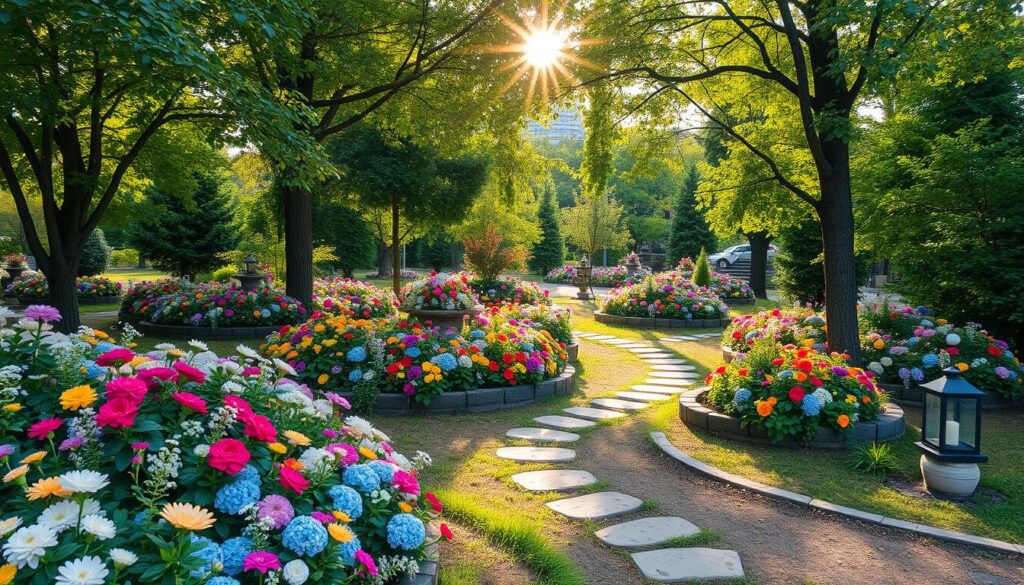Did you know memorial gardens are seen as more joyful than traditional cemeteries? They bring peace and natural beauty to the mourning process. This shows the big differences between memorial gardens and cemeteries, more than just looks.
Memorial gardens have special features like scattering areas, memorial trees, and benches. They offer a less formal place than traditional burial grounds. Funeral homes now call their burial grounds “memorial gardens” to show a move towards modern landscaping. This creates calm and meaningful spaces.
Key Takeaways
- Memorial gardens are generally perceived as more light and joyful compared to traditional cemeteries.
- Memorial gardens incorporate unique elements like scattering areas, memorial trees, and benches, offering a less formal setting.
- Funeral homes are increasingly using the term “memorial garden” instead of “cemetery” to reflect a shift towards creating serene and meaningful environments.
- Cremation scattering areas in memorial gardens provide peaceful resting places for loved ones’ ashes.
- Memorial gardens aim to eliminate the dark and gloomy atmosphere associated with traditional cemeteries.
Understanding the Distinct Types of Final Resting Places
Cemeteries: Traditional Burial Grounds
Cemeteries have long been a traditional choice for final resting places. They offer a range of options to honor the departed. From monumental cemeteries with tall headstones to garden cemeteries with a park-like setting, the diversity is remarkable.
Municipal cemeteries are owned by local governments and serve the community. Religious cemeteries are for specific faith groups, meeting their spiritual needs.
VA cemeteries honor military heroes with dignity. Family burial grounds offer a private space for loved ones.
Natural burial grounds and green burial sites are eco-friendly. They minimize environmental impact, appealing to those seeking sustainability.
Cemeteries are vital in our society, providing a sacred space for mourning and remembrance. Understanding the different types helps us make choices that reflect our beliefs.
| Cemetery Type | Description | Key Features |
|---|---|---|
| Monumental Cemetery | Cemeteries featuring upright headstones and monuments | Tall, imposing memorials; formal, structured layout |
| Memorial Park | Cemeteries with a more natural, park-like environment | Landscaped grounds; flat or flush markers; emphasis on nature |
| Garden Cemetery | Cemeteries designed with a focus on horticultural elements | Lush gardens; varied flora; serene, contemplative atmosphere |
| Religious Cemetery | Cemeteries owned and operated by specific faith groups | Adherence to religious customs and traditions; spiritual significance |
| Municipal Cemetery | Cemeteries owned and managed by local governments | Serve the broader community; affordable options |
| Natural Burial Ground | Cemeteries focused on environmentally-friendly burials | Minimal environmental impact; ecological preservation |
| VA Cemetery | Cemeteries operated by the U.S. Department of Veterans Affairs | Honor the service and sacrifice of military members |
| Family Burial Ground | Private burial sites owned and used by individual families | Intimate, personal setting; familial legacy |
“Cemeteries remain an integral part of our society, offering a sacred space for mourning, remembrance, and honoring the lives of those who have passed.”
The Rise of Memorial Parks and Gardens
In recent years, memorial parks and gardens have become more popular. They offer a calm, nature-like setting for remembering loved ones. People now want a peaceful and beautiful place for their final rest.
These spaces have well-planned landscapes and special features. They give a more dignified and personal experience than old cemeteries. This change shows a shift towards natural, friendly-to-the-environment burial options.
The trend towards memorial parks and gardens is growing. It’s because people want natural burial grounds and a unique memorial experience. These spaces use special burial methods, like tree-marked graves, for a more natural feel.
Environmental concerns also play a role. Memorial parks and gardens are seen as a greener option. They provide a calm, sustainable place for final rest.
As people’s needs change, memorial parks and gardens will keep growing. They offer a personal and meaningful way to remember those who have passed.
| Memorial Parks and Gardens | Traditional Cemeteries |
|---|---|
| Carefully planned landscaping and architecture | Often crowded and confusing layout |
| Serene, nature-inspired setting | Formal, uniform appearance |
| Personalized memorial experience | Impersonal, standardized approach |
| Eco-friendly and sustainable | Higher environmental impact |
“The memorial garden is a place of solace, where the living can connect with the memory of their loved ones and find comfort in the natural surroundings.”
The rise of memorial parks and gardens shows a change in how people want to honor their loved ones. These spaces offer a calm, green alternative to old cemeteries. They provide a unique and beautiful setting for remembrance and reflection.
What is the Difference Between a Memorial Garden and a Cemetery?
Choosing between a memorial garden and a traditional cemetery is a big decision. It affects how we honor and remember our loved ones. The main differences are in design, services, and the overall feel.
Memorial gardens look like parks, with ash scattering gardens and memorial trees. Cemeteries, on the other hand, have a formal layout with upright headstones and monuments.
Memorial gardens are private, offering a more personal experience. They provide many ways to remember loved ones, like scattering ashes or planting memorial trees. Cemeteries, being public, have more limited options but can unite families across generations.
“Memorial gardens are increasingly becoming popular as serene and picturesque resting places for loved ones.”
The choice between a memorial garden and a cemetery depends on personal taste and what you want to remember your loved ones by. Both offer unique ways to honor and celebrate their lives.

Services and Memorialization Options in Memorial Gardens
Memorial gardens are a special way to remember loved ones. They offer more than just traditional burials. These peaceful places have many services and ways to honor the memory of those who have passed.
Ash Scattering Gardens and Memorial Trees
Ash scattering gardens are a key feature of memorial gardens. They are designed for families to scatter the ashes of their loved ones. This creates a calm place surrounded by nature. Many gardens also let you plant a memorial tree or shrub.
These options let families connect with nature in a meaningful way. It’s a greener choice than traditional burials. By choosing a memorial garden, families can find peace and help the environment at the same time.
| Memorialization Option | Description |
|---|---|
| Ash Scattering Gardens | Serene, landscaped areas where families can respectfully scatter the cremated remains of their loved ones. |
| Memorial Trees and Shrubs | Living tributes that allow families to dedicate a tree or shrub in memory of the deceased, with a personalized marker placed at the base. |
“By choosing a memorial garden, individuals can find comfort in the personalized and natural setting, while also contributing to the preservation of the environment.”
The Benefits of Choosing a Memorial Garden
Choosing between a traditional cemetery and a memorial garden is a big decision. Memorial gardens offer a calm, nature-inspired place for reflection. They are different from the formal, structured cemeteries.
Memorial gardens provide personalized services that traditional cemeteries can’t match. Families can pick from many options, like ash scattering and tree dedications. This lets them create a special tribute for their loved one.
Also, memorial gardens are often better cared for than public cemeteries. Being privately owned, they get more attention. This means visitors can find peace and solace in a well-kept environment.
Another advantage of a memorial garden is the eco-friendly burial options they offer. They use sustainable practices like natural burials. This way, families can honor their loved ones while being kind to the environment.
“Memorial gardens provide a serene, nature-inspired setting that encourages reflection and connection with the natural world.”
The benefits of choosing a memorial garden go beyond the physical space. These spaces offer a peaceful setting for families to grieve and celebrate. They create a lasting legacy that connects with nature’s beauty.
Planning and Preparing for a Memorial Garden Service
Creating a memorial garden service is a special way to honor a loved one. It’s important to pick a location that feels right for you. This choice should reflect your needs and what you’re looking for.
Selecting the Right Location
Start by looking at different memorial gardens in your area. Think about the design, services offered, and how you can personalize it. The location’s ease of access and atmosphere are also key.
Choosing the right garden helps make the service a true reflection of your loved one. Take your time to find the perfect spot. This way, you can create a service that is both personal and meaningful.
| Memorial Garden Feature | Importance |
|---|---|
| Landscaping and Design | The overall look and feel of the garden set the mood for the service. |
| Memorial Service Options | Services like ash scattering and tree dedications make the tribute unique and heartfelt. |
| Accessibility and Location | The garden’s location and ease of access affect the comfort and experience of guests. |

Keep these factors in mind to choose the best memorial garden. This will ensure a fitting and memorable tribute to your loved one.
Visitation and Celebration at Memorial Gardens
Memorial gardens are peaceful places for visiting and honoring loved ones. Families can come to reflect, leave flowers, and connect with nature. These gardens also host events for people to share their experiences and find comfort together.
Visiting and celebrating in memorial gardens is key to healing. These spaces help people remember, build community, and find support. They offer a place to connect and feel supported during tough times.
| Visitation Options | Celebration Opportunities |
|---|---|
|
|
Memorial gardens offer special chances for visitation and celebration. They provide a sacred space for honoring loved ones, finding solace, and keeping memories alive. These gardens help individuals and communities connect with the memories of those who have passed.
“The memorial garden has become a cherished place for our family to gather and remember our loved one. It’s a space that brings us comfort and a sense of peace.”
The Evolution of Memorial Gardens in Modern Society
In recent years, memorial gardens have changed a lot. This change shows how modern society’s values have shifted. People now want eco-friendly and personalized ways to remember their loved ones. Memorial gardens have started to offer these options.
Now, we see more ash scattering gardens and memorial trees. These are natural ways to honor someone, with less harm to the environment. The settings of these gardens are also key. They provide a peaceful place for people to remember and reflect.
Today, memorial gardens focus more on personalization. Families can choose from many options, like custom markers or digital tributes. This lets them create a special tribute that shows who their loved one was.
As society’s burial preferences change, memorial gardens adapt. They offer green options, personal services, and beautiful natural settings. These spaces are now places of life and memory, meeting the needs of both the living and the deceased.
| Key Trends in Memorial Garden Evolution | Explanation |
|---|---|
| Eco-friendly Burial Options | Memorial gardens are offering ash scattering gardens and memorial trees as alternatives to traditional burials, addressing the growing demand for environmentally-conscious memorialization. |
| Personalized Memorialization | Memorial gardens are providing a wider range of customization options, allowing families to create a unique and meaningful tribute that reflects the life of their loved one. |
| Thoughtfully Designed Natural Settings | Memorial gardens are emphasizing the importance of creating serene and contemplative spaces that promote connection and reflection for visitors. |
“Memorial gardens have become vibrant and meaningful destinations that celebrate the lives of the deceased while also addressing the desires of the living.”
As memorial gardens evolve, they will become even more important. They will help modern society honor and remember its loved ones in new and meaningful ways.
Conclusion
Memorial gardens and traditional cemeteries differ in design, services, and atmosphere. Memorial gardens have a natural, park-like feel with features like ash scattering gardens and memorial trees. In contrast, cemeteries have a more formal layout.
Memorial gardens offer more personalized memorial options and are privately owned. This ensures better care and attention. They are becoming more popular for their eco-friendly and meaningful final resting places.
These serene settings allow families to create lasting tributes. They honor loved ones in ways that reflect personal values and preferences. This can include planting memorial trees or scattering ashes in dedicated gardens.
Choosing a memorial garden over a traditional cemetery has many benefits. It allows for personalized memorialization and offers tranquil, natural surroundings. These surroundings provide peace and comfort.
The appeal of memorial gardens is growing. They offer families a more personalized and meaningful way to celebrate lives. As the industry evolves, memorial gardens will likely become an even more popular choice.
FAQ
What are the key differences between memorial gardens and traditional cemeteries?
Memorial gardens are more natural and park-like. They have ash scattering gardens and memorial trees. Traditional cemeteries have a formal layout with upright headstones.
Memorial gardens are privately owned, offering a personal experience. Traditional cemeteries are public, managed by local governments.
What types of cemeteries are there?
There are many types of cemeteries. These include monumental, memorial parks, garden, and religious cemeteries. There are also municipal, natural burial, VA, and family burial grounds.
Each type reflects the community’s religion, culture, and traditions.
How have memorial parks and gardens become more popular in recent decades?
Memorial parks and gardens are now more popular. They offer a peaceful, nature-inspired setting. This is different from older cemeteries.
Developers and private institutions have met people’s changing preferences. They now want a more serene final resting place.
What services and memorialization options are available in memorial gardens?
Memorial gardens offer many services. They have ash scattering gardens for cremated remains. You can also dedicate a tree or shrub as a living tribute.
Each option comes with a personalized memorial marker.
What are the benefits of choosing a memorial garden over a traditional cemetery?
Memorial gardens offer a peaceful setting for reflection. They are more nature-inspired than traditional cemeteries. This encourages a connection with nature.
They also have more memorialization options. Private ownership means better care and attention compared to public cemeteries.
What should I consider when planning a memorial service in a memorial garden?
When planning a memorial service, consider the location and services. Research the memorial garden options in your area. Look at the design, memorialization options, and personalization available.
How do memorial gardens provide opportunities for visitation and celebration?
Memorial gardens offer a peaceful environment for visitation and celebration. Families can reflect, leave tributes, and connect with nature. Many host remembrance events and community gatherings.
These events allow people to honor their loved ones and find solace in shared experiences.
How have memorial gardens evolved in recent years?
Memorial gardens have evolved to meet modern preferences. They now offer eco-friendly and personalized options. This includes ash scattering gardens, memorial trees, and natural settings.



